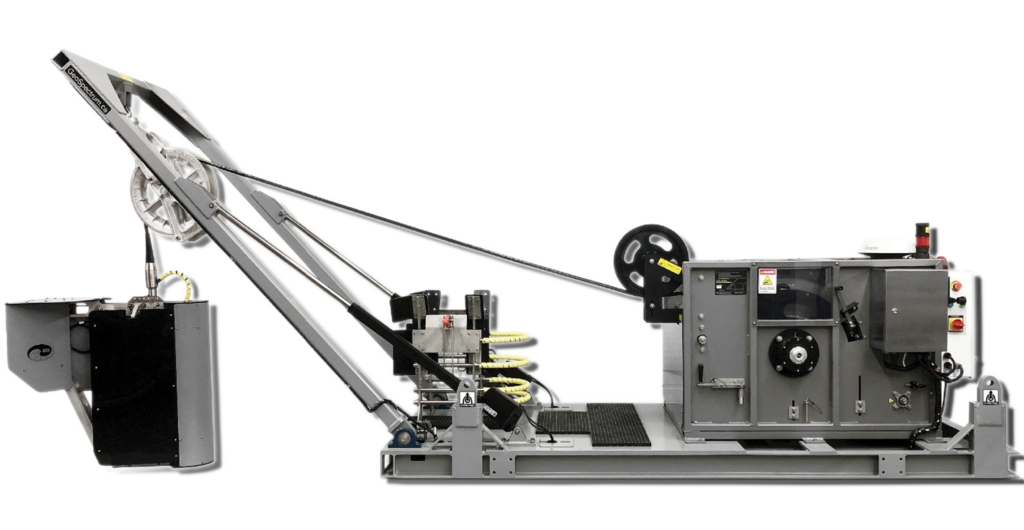E x·pend·a·ble (of an object) designed to be used only once and then abandoned or destroyed.
For decades, expendable Anti-Submarine Warfare (ASW) training targets (also referred to as expendables) have been a low-cost solution for naval operator training and contribute to the overall readiness of naval forces, ensuring they can meet operational requirements.
The targets currently available on the market are highly effective in terms of their ease of use. The expendables are designed for imitating submarine noise and can be programmed easily according to ASW exercise requirements. These portable devices can be effortlessly thrown off the ship’s side, and, as the name suggests, require no recovery efforts.

GeoSpectrum’s Portable Acoustic Target system (Photo credit: GeoSpectrum Technologies Inc.)
Logistically, they make a lot of sense but aren’t without limitations. With conventional methods, expendable targets fail to provide the required training for several reasons. Cost-effective expendables allow passive and active detection, but many do not operate in low-frequency (LF) ranges which renders them useless for LF sonar training exercises. They generate passive discrete tones, broadband noise, active emissions, and echo repeats but have a limited number of bands and are limited in the frequency spectrum they can broadcast based on power and size limitations.
In addition, large quantities of expendables are needed to obtain sufficient training hours. When speaking with former Sonar Chief, Wallace Bennett, he notes that you can “program it and chuck it…but I’ve also been out with targets that have been part of a bad batch, and now you have nothing.”
ENVIRONMENTAL WEIGH-IN
Another important aspect to consider is the assessment of a given acoustic equipment’s environmental impact on the ocean and its inhabitants.
Acoustic devices include everything from large-scale sonar systems to smaller underwater projectors and hydrophones. While they serve important purposes in various industries, their improper disposal or accidental loss has led to a disturbing accumulation in our oceans. Wallace speculates, “If you went on the ocean floor there would be hundreds of thousands of expendable equipment.” This waste not only pollutes the ocean environment through disintegration but poses a serious risk to marine animals, disrupting their natural behaviors and potentially causing long-term harm.
Once an expendable has completed its mission and depleted its battery, it sinks to the ocean floor where it gradually disintegrates. Traditional expendable targets contain a litany of substances such as heavy metals and plastics – both of which are toxic substances that can affect marine life through absorption and/or ingestion which can then infiltrate the food chain.
In the naval market, there is an increasing recognition of the need for a better balance between acoustic capability and environmental impact, leading to the growing popularity of reusable targets. When designing new and innovative defence technology, companies such as GeoSpectrum Technologies Inc. (GeoSpectrum) strive to minimize their ecological footprint while maintaining a high level of standard for their system performance.
REUSABLE SOLUTIONS
In comparison, a reusable target such as GeoSpectrum’s Portable Acoustic Target (PAT), is a flexible system that supports active and passive ASW training, system validation, and trials over the full range of the sonar system configurations. Like the expendable targets, PAT can be used as a synthetic target to confirm sonar systems including Hull Mounted Sonars, Towed Array Sonars, sonobuoy processors, and fixed surveillance systems, can actively and passively detect and track sub-surface contacts. It is an end-to-end system that acts as an echo repeater for active sonar in low-frequency and medium-frequency bands and as a passive acoustic target by transmitting preprogrammed sounds across a greater range of frequencies than most training targets.
Though similar in high-level function to expendable targets, PAT offers a more robust solution featuring a towed body and compact handling/stowage system with operator-controlled signal generation and monitoring software. PAT includes full recording of acoustic signals, position, and target telemetry data. This additional data can be very valuable for mission reconstruction, performance assessment, and ultimately operational advancements.
One of the many key differences between the expendable target and PAT is that once the expendable is deployed, there is no way of turning off or altering the scenario. Comparatively, if a marine mammal is detected or a change is required for operational reasons, PAT can be turned off instantaneously or quickly adjusted to react to a dynamic scenario. This includes the option to adjust the source level on the fly to meet the requirements of sonar ramp-up procedures according to SARA (Species at Risk Act) or other reasons. Most expendable targets are limited to pre-programmed source levels with no ability to alter or terminate the run if a problem occurs of an adjustment is warranted.
Thus, PAT can be readily incorporated into current and future operator and team training at all levels, from basic to advanced. As well, the difficulty of the training scenario can be customized at a moment’s notice or terminated and rescheduled to accommodate changes in a ship’s program. The flexibility and user-friendly nature of PAT enables operators to quickly understand and optimize the capabilities of their sonar systems and tactics in a non-combat environment. This can be accomplished through increased training opportunities and a wide variety of target emulation options to provide a multitude of ASW scenarios in realistic environments.
In addition to the fact that it eliminates the need to use less capable, expendable targets, it also reduces reliance on submarine participation in trials and exercises. This ultimately saves costs and increases opportunities for test and training events within a specified budget. Evaluating the effectiveness of training targets is an ongoing process. By regularly analyzing the results of these training exercises, adjustments can be made to maximize their capabilities and address any identified areas of improvement.
“The PAT system is more robust, and we’ve been putting it through the paces…it’s gaining traction in the market.”, Wallace comments. Although both systems, expendable targets, and end-to-end solutions like PAT, have their place on the market, there’s a need for greater training and mission capabilities for naval operators and companies like GeoSpectrum are answering the call.


